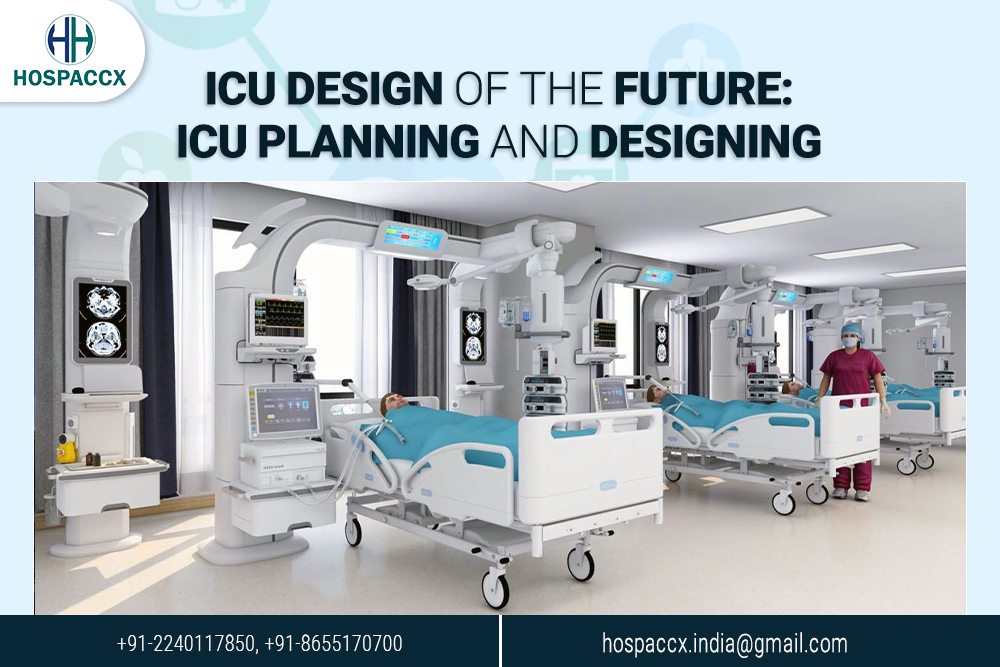INTRODUCTION
ICU is highly specified and sophisticated area of a hospital which is specifically designed, staffed, located, furnished and equipped, dedicated to management of critically sick patient, injuries or complications.
Designing an intensive care unit (ICU) to handle the needs of critically ill patients in the future requires both an ability to predict which of today’s healthcare trends will still be influential 20 years from now and the flexibility to adapt to these trends.
Considering the above facts, Hospaccx team participates in the market trends and dynamic of future ICU design. This is macroficial study of ICU design of the Future: ICU Planning and Designing if you want to get into more detail you can contact hospaccxconsulting.com
WHY BUILD A NEW ICU OR RENOVATE AN OLD ONE?
- Hospitals undertake ICU construction for many reasons: to adapt to changing patient demographics or disease patterns; to upgrade or add services; and to accommodate changes in the information, materials, or patients.
- New construction may become cost effective when an older ICU requires expensive repairs or upkeep to remain viable, or simply ceases to function well.
- Changes in performance standards and new issues in reimbursement and risk management may suggest alterations.
- Designing for infection control by separating patients, adding isolation facilities, adding hand hygiene stations, upgrading mechanical ventilation and re- vising provisions for disposal of human waste, or introduction of antimicrobial materials can lower infection rates and therefore morbidity and mortality, cost per case, and length of stay.
LEVELS OF INTENSIVE CARE UNITS
LEVEL 1
- should be capable of providing immediate resuscitation and short-term cardiorespiratory support for critically ill patients
- will also have a major role in monitoring and prevention of complications in “at risk” medical and surgical patients
- must be capable of providing mechanical ventilation and simple invasive cardiovascular monitoring for a period of at least several hours
LEVEL II
- should be capable of providing a high standard of general intensive care, including complex multi-system life support, which supports the hospital’s delineated responsibilities
- minimum of 6 beds
LEVEL III
- a tertiary referral unit for intensive care patients
- should be capable of providing comprehensive critical care including complex multi-system life support for an indefinite period
- should have a demonstrated commitment to academic education and research
- All patients admitted to the unit must be referred for management to the attending intensive care specialist
- all consultants are FCICMs
- may have over 50 beds, should include pods of 8-15 beds
PICU
- as for a Level III unit, but dedicated to the care of patients under the age of 16 years
ICU Architecture Firm
FUTURE ICU DESIGN
- Ensure room clearances include adequate space for the movement of medical equipment, wheelchairs and furniture. Creating a room large enough to absorb additional functions as time moves forward can ensure functionality in the long-term.
- Use of technology to deliver evidence- based care and to design patient and family- centred care processes. Their prototype included wireless technology and equipment (e.g., implantable patient monitors and treatment microsystems), and voice-activated information and communication systems to access and integrate history, physical findings, and diagnostic data.
- Improve situational awareness and coordination of care between providers and families. Their design centred on a wall mounted computer display to continuously orient clinicians and family members to current and future plans for care. The system provided computerised facial identification of providers and their specific roles in care delivery, displayed reminders of required care and virtual huddles for handoffs, and had electronic location monitors to eliminate delays from tracking down staff, patients, or family members.
- Invented an automated head-mounted technology controlled by voice or eye blinks. Caregivers used it to access, document, and share patient data, record rounds, and complete hospital requirements (e.g., populating the patient record, clinical credentialing). This technology had a patient dashboard of key clinical indicators.
- An artificial intelligence agent might reduce caregiver anxiety. They posited that the major causes of anxiety were a sense that heroic action was frequently needed and a fear that making a mistake would harm a patient. The team conceived a voice-prompted, tablet based, virtual personal assistant (avatar) to completely support caregiver needs (e.g., calculate medication dosages, remind caregiver about a needed intervention).
- Equip the space with adequate storage for devices and common medical supplies like linens and medications. Make sure often used supplies are located near the patient to promote efficiency. Use size, colour and texture to distinguish storage spaces for medical supplies.
- Provide enough lighting between the bed and bathroom to reduce the likelihood of patient falls. Also, sufficient lighting in the medication prep zone can allow providers to better check patient arm bands to ensure proper care delivery.
- Cut into the innate noise of the ICU with equipment and technologies designed to mask noise. Also, providing patients access to music to cover the noise of the ICU is a good way to reduce stress levels.
- Situate family space in the line-of-sight of providers to facilitate inclusion into the care conversation. Also, position furniture out of the way of the caregiver zone in an area that allows visitors to see and hear the TV without disturbing the patient. Furniture should also be in place to allow visitors to make physical contact with the patient when desired.
CONCLUSION
A critical care unit design not only functions as an ICU but also has a human element for the delivery of critical care. They need to be safe, secure, efficient, innovative, creative and aesthetic. Therefore, the focus of a successful ICU design for the future must include both functional and humanitarian elements to comfort patients, relatives and easy going with healthcare professionals.
Are you planning to design your ICU? We can help you to design your dream project, below are the healthcare design services that we offer:-
- Healthcare Architecture Design services
- MEP Design
- Landscape Design services
- Structural Design services
- Interior Design services
It is the superficial and macro level study for more details kindly contact Hospaccx Healthcare business consulting Pvt. ltd on on www.hospaccxconsulting.com
Related Team Members




















